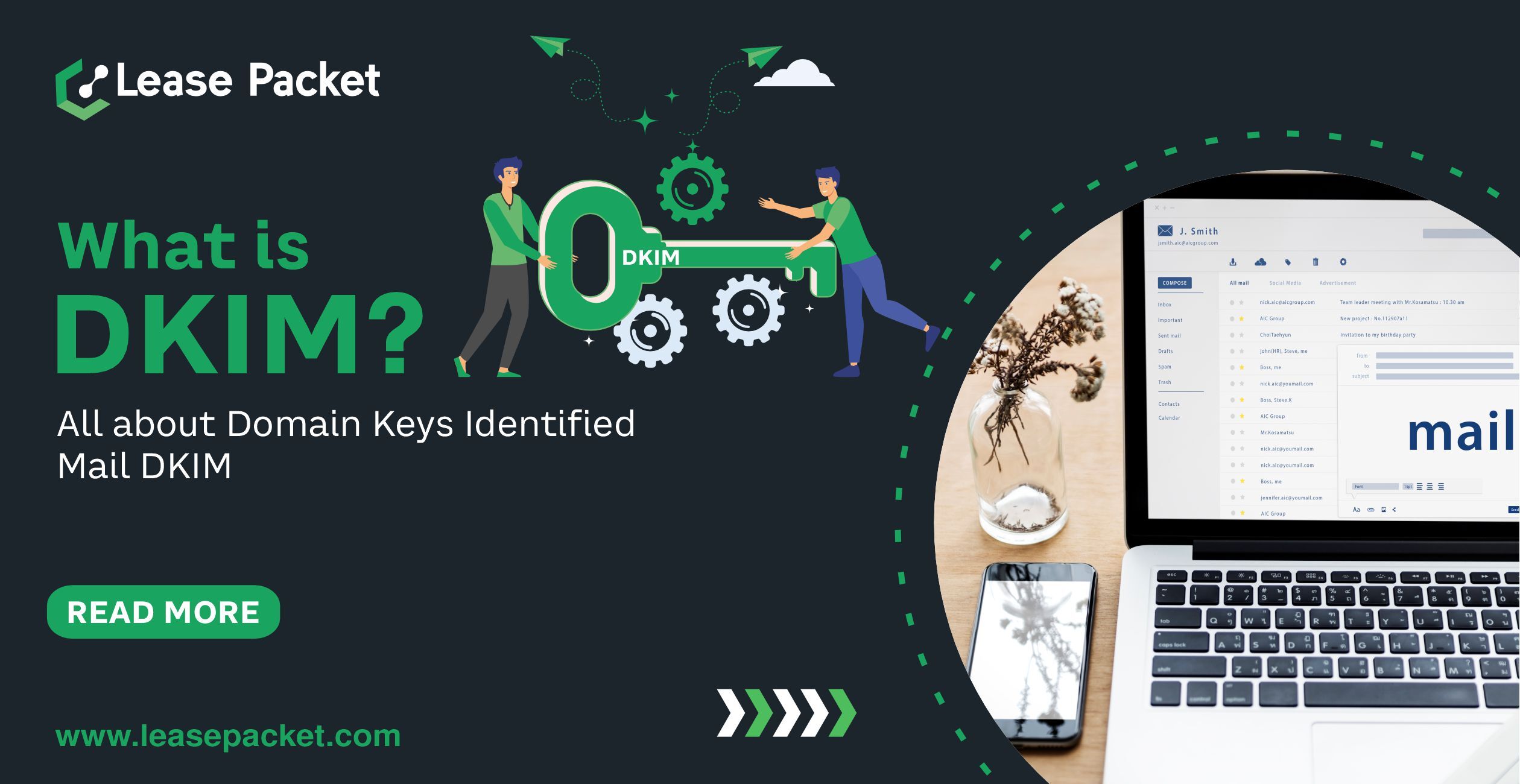What is DKIM? All About Domain Keys Identified Mail (DKIM)
 Lease Packet
Lease Packet
Email is one of the most common ways we communicate, whether for personal use or business. But with the convenience of email comes the risk of spam, phishing attacks, and email forgery. To protect against these threats, various security measures have been developed. One such measure is DKIM, which stands for DomainKeys Identified Mail. In this blog, we’ll explore what DKIM is, how it works, and why it’s important for securing your email.
What is DKIM?
DomainKeys Identified Mail (DKIM) is an email authentication method designed to protect email senders and recipients from spam, spoofing, and phishing attacks. DKIM allows the receiver of an email to verify that the email was indeed sent by the domain it claims to be from and that the email has not been altered in transit.
In simpler terms, DKIM helps you make sure that an email is legitimate and hasn’t been tampered with while it was being delivered.
How Does DKIM Work?
DKIM works by adding a digital signature to each outgoing email. This signature is created using a pair of cryptographic keys: a private key and a public key. Here’s a breakdown of how the process works:
Generating Keys:
The email sender’s domain (like example.com) generates a pair of keys: a private key and a public key.
The private key is kept secret and is used to sign outgoing emails.
The public key is published in the domain’s DNS (Domain Name System) records, where it can be accessed by anyone.
Signing the Email:
When an email is sent from the domain, the email server uses the private key to create a digital signature.
This signature is added to the email header (a section of the email that contains technical details about the message).
Verifying the Email:
When the email is received, the recipient’s email server looks up the public key in the sender’s DNS records.
The server then uses the public key to verify the digital signature in the email header.
If the signature is valid, it means that the email was indeed sent from the claimed domain and has not been altered in transit.
Why is DKIM Important?
DKIM is crucial for several reasons:
Protects Against Email Forgery:
Without DKIM, it’s easy for malicious actors to send emails that appear to be from a trusted domain. DKIM helps prevent this by ensuring that only emails signed with the legitimate domain’s private key are considered valid.
Improves Email Deliverability:
Many email providers check for DKIM signatures when deciding whether to deliver an email to the inbox or spam folder. Having DKIM properly configured can improve the chances that your emails reach the intended recipients.
Increases Trust:
When your emails are signed with DKIM, it helps build trust with your recipients. They can be more confident that the emails they receive from your domain are legitimate.
Works with Other Email Security Protocols:
DKIM works alongside other email authentication methods like SPF (Sender Policy Framework) and DMARC (Domain-based Message Authentication, Reporting & Conformance) to provide a comprehensive security solution for email.
How to Set Up DKIM
Setting up DKIM involves a few steps, but it’s a critical process for securing your email. Here’s a basic outline of how to do it:
Generate DKIM Keys:
Your email server or provider will have tools to generate a private and public DKIM key pair.
Publish the Public Key in DNS:
- The public key needs to be added to your domain’s DNS records. This is usually done by creating a TXT record in your DNS settings.
Configure Your Email Server:
Set up your email server to sign outgoing emails with the private key.
Test Your Setup:
Once DKIM is set up, you can send test emails to check if the signatures are being correctly applied and verified.
Many popular email providers, such as Google Workspace, Microsoft 365, and others, offer built-in support for DKIM, making it easier to set up and manage.
Common DKIM Issues and Troubleshooting
While DKIM is a powerful tool, it’s not without its challenges. Here are some common issues you might encounter and how to address them:
Misconfigured DNS Records:
- If the public key is not correctly published in the DNS records, DKIM verification will fail. Double-check the DNS settings to ensure the TXT record is accurate.
Email Forwarding Issues:
- Sometimes, emails that are forwarded can lose their DKIM signatures, leading to verification failures. In these cases, consider using DMARC in conjunction with DKIM to provide additional protection.
Inconsistent Signing:
- Ensure that all outgoing emails from your domain are signed with DKIM. Inconsistent signing can cause some emails to be marked as suspicious.
Key Length:
- Some older systems may not support longer DKIM keys. Make sure your key length is compatible with both your email server and recipient servers.
DKIM and Your Email Security Strategy
DKIM is an essential part of a broader email security strategy. While it provides a strong layer of protection, it works best when combined with other methods like SPF and DMARC. Together, these protocols help ensure that your emails are not only delivered to the right recipients but also protected from tampering and forgery.
Conclusion
DomainKeys Identified Mail (DKIM) is a vital tool in the fight against email fraud. By ensuring that your emails are properly authenticated and protected from tampering, DKIM helps safeguard your communication and maintain the trust of your recipients. Whether you’re running a business or managing a personal domain, setting up DKIM is a step you shouldn’t skip.
With DKIM in place, you can be more confident that your emails will reach their destination securely and without the risk of being marked as spam or, worse, used for malicious purposes.
FAQs
What is DKIM, and why is it important?
DKIM (DomainKeys Identified Mail) is an email authentication method that helps verify that an email was sent from a legitimate domain and has not been tampered with in transit. It’s important for protecting against email forgery, spam, and phishing attacks.
How does DKIM work?
DKIM works by adding a digital signature to outgoing emails. This signature is created using a private key, and the corresponding public key is published in the domain's DNS records. When an email is received, the recipient's server uses the public key to verify the signature and ensure the email's authenticity.
What are the benefits of using DKIM?
DKIM helps protect against email forgery, improves email deliverability, builds trust with recipients, and works alongside other email security protocols like SPF and DMARC to provide comprehensive protection.
How do I set up DKIM for my domain?
Setting up DKIM involves generating a pair of cryptographic keys, publishing the public key in your domain's DNS records, configuring your email server to sign outgoing emails with the private key, and testing the setup to ensure it’s working correctly.
Can DKIM prevent all email-related security threats?
While DKIM is a powerful tool, it’s not a complete solution on its own. It works best when used in conjunction with other email security protocols like SPF and DMARC to provide a robust defense against various email threats.
What should I do if DKIM verification fails for my emails?
If DKIM verification fails, check your DNS records to ensure the public key is correctly published, and make sure your email server is properly configured to sign outgoing emails. It may also help to test your DKIM setup using online tools designed for this purpose.
Subscribe to my newsletter
Read articles from Lease Packet directly inside your inbox. Subscribe to the newsletter, and don't miss out.
Written by

Lease Packet
Lease Packet
Lease Packet provides the world’s most extensive data center infrastructure and is a global leader in delivering managed server solutions.